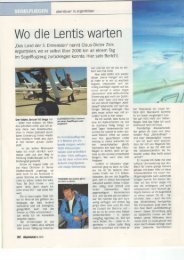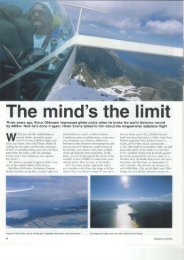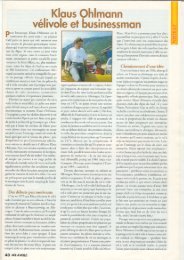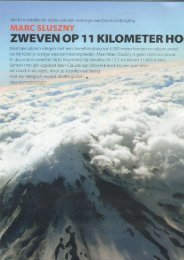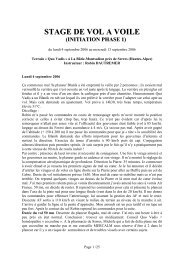Create successful ePaper yourself
Turn your PDF publications into a flip-book with our unique Google optimized e-Paper software.
WINNING ON THE WAVE<br />
I<br />
IKE PUTTING a man on the moon,<br />
I<br />
climbing to the top of Everest or<br />
tstrudging to the South Pole the Kûttner<br />
Prize was a race - a contest of endurance<br />
and skill in an extreme and unexplored<br />
environment. The goal? To fly 2,000km<br />
- 1,243 miles - in one direction, replacing<br />
the power of combustion with the power<br />
of nature. lt was a prize rooted in the very<br />
beginnings of gliding - and a dream thar<br />
was only realised within the last year.<br />
When soaring was in its infancy, pilots<br />
believed that wind on the lee of hills and<br />
mountains hugged the ground, producing<br />
downdrafts. Hans Deutschmann and<br />
Wolf Hirth, two Cerman glider pilots,<br />
serendipitously discovered a powerful type<br />
of lift while soaring over a small hill in<br />
Silisea, Cermany, in 1933. In the flimsy<br />
wooden and canvas glider Deutschmann<br />
and Hirth were thrust skyward gaining a lot<br />
of altitude rapidly.<br />
Joachim Kûttner, a young scientist and<br />
talented glider pilot, was the first to study<br />
scientifically this phenomenon on the lee<br />
side of mountains. During a gathering of<br />
soaring enthusiasts in a small competition<br />
he convinced the pilots to carry instruments<br />
to record their flights. When he analysed the<br />
data, Kûttner confirmed his suspicions that<br />
wind flowing over mountains generates<br />
waves very similar to standing waves or<br />
rapids in a river. These days, every glider<br />
pilot knows that - like a river flowing over<br />
boulders - wind encountering mountains<br />
forms a series of standing waves downwind,<br />
and on the front edge of each you can find<br />
very smooth, powerful lift. But it was Kûttner<br />
who coined the phrase "mountain waves".<br />
He spent his early career exploring them.<br />
When a wave is really pumping, its<br />
power is palpable. The sound frequency of<br />
mountain waves is too low to hear but the<br />
pressure fluctuations generated can be felt<br />
through your body as a deep resonating<br />
hum. The sub-audible vibration can build<br />
tension like a bow being drawn across the<br />
bass note of a cello. ln 1937, Kùttner stood<br />
below such a wave in Riesengebirge,<br />
Cermany. Dwarfed beneath the huge cigarand<br />
saucer-shaped clouds, ignited by visceral<br />
excitement, apprehension and desire to<br />
explore how high the wave reached, Kûttner<br />
took his fragile low-performance wooden<br />
glider into the jaws of his first giant wave.<br />
Flying in front of the cloud in an open<br />
cockpit he soon caught the ascending air.<br />
The altimeter was adequate for most aircraft<br />
of the day: few ever flew higher than its<br />
maximum of 10,000ft (3,048m). Soon it<br />
became useless as he wound it off the dial.<br />
Most pilots begin breathing supplemental<br />
oxygen at 10,000f1 but back in 1937 the<br />
body's oxygen requirements at high altitude<br />
were poorly understood and Kûttner flew<br />
without the luxury of oxygen.<br />
At 12,000ft (3,658m) the air temperature<br />
dropped well below freezing but Kûttner<br />
remained in lift and continued climbing.<br />
At 20,000f1 (6,096m) his extremities started<br />
to lose circulation and began feel very cold,<br />
36<br />
Opening picture, overleaf: Soaring wave 30,000ft above<br />
New Zealand. Photos like this, taken by Marty Taylor<br />
with the help of Gavin Wills, will be used in a highguatity<br />
calendar available from www.exiremegliding.com<br />
and oxygen deprivation would have started<br />
to affect his judgment. lmpelled by the<br />
explorer's desire to go where no one had<br />
been before and bv the scientist's curiositv.<br />
Kùttner was able tô over-ride his extreme<br />
discomfort, but he was unaware of the real<br />
danger stalking him. With less oxygen his<br />
judgment became blunted by euphoria.<br />
At 23,000fr (7,010m) and enduring -35'C<br />
Kûttner realised that he could no longer feel<br />
his frostbitten feet and that his fingers had<br />
turned blue. Such extreme cold would have<br />
forced many pilots to abandon the flight but<br />
the decision to retreat only came when<br />
Kûttner realised he was seeing two suns. The<br />
creep of cognitive impairment due to oxygen<br />
deficit is insidious and a pilot can often fly<br />
without noticing the signs that something<br />
is not quite right. Seeing two suns was a<br />
clear-cut sign that something was severely<br />
wrong. At this point Kùttner turned away<br />
from the lift and rapidly descended landing<br />
in a small Polish village a long way from his<br />
start point. His physical ailments soon<br />
healed but he never recovered from his<br />
desire to understand and explore the power<br />
and beauty of the mountain wave.<br />
Sierra Wave Project<br />
Two years after this flight World War Two<br />
intervened, putting Kûttner's plans to studv<br />
and explore wave on hold while he flew as<br />
a test pilot for the Cerman aircraft industrr,.<br />
After recovering from the horrors of the w,ar,<br />
Kûttner joined the Sierra Wave Project - a<br />
meteorological programme run by the<br />
US Air Force to investigate mountain wave.<br />
The Sierra Nevada is an old mountain<br />
range that has been battered and eroded<br />
by winds ploughing into it. After countless<br />
millions of years the ranges are shaped more<br />
like the top half an aerofoil than the jagged,<br />
mitred peaks of young mountains. The<br />
smooth shape and gentle curve of the Sierra<br />
Nevadas commonly trigger a spectacular<br />
lee wave. Once in the wave a pilot can<br />
expect serenely silk-smooth lift without even<br />
the slightest hint of turbulence. However,<br />
wave harbours an unpleasant, less benign,<br />
bedfellow: rotor. On April25,1955, Kûttner<br />
and his colleague Larry Edgar were on a<br />
routine investigative flight when they<br />
encountered the full furv of a demon rotor.<br />
After several hours' flying between 30,000ft<br />
and 40,000ft (9,144-12,192m) the pair<br />
descended: Kùttner first, then Edgar. At<br />
17,OOOft (5,'181m) Kùttner was ripped into<br />
by horizontal sheets of wind that catapulted<br />
him within seconds of his glider's maximum<br />
speed. Fast approachingVNe, Kûttner pulled<br />
up and climbed vertically. He still had too<br />
much speed. The next option was a highspeed<br />
stall. After dropping nearly 1,000ft he<br />
recovered only to be hit by another gust. He<br />
must warn Edgar. lt was too late. The same<br />
belt of destructive turbulence had consumed<br />
Edgar. Porrerrul rotor clouds were forming<br />
all around hinr. L'nsighted by the rapidly<br />
forming cloud he could not execute the<br />
same escape Kùttner had performed without<br />
losing contr()l of his plane. The terrific power<br />
of the rotor brut..rllr flung Edgar pastVNr<br />
with a force of I lC and rvrenched the wings<br />
off his glider - hurling him out of the plane.<br />
Edgar's parachute opened itself while his feet<br />
were caught in the cockpit. The shear forces<br />
were enough to have torn him in two.<br />
Luckily, the onlv casualties were his boots,<br />
helmet and gloves. The enormous C-forces<br />
blinded him and the hose from his bailout<br />
oxygen bottle was destroyed.<br />
Out of the plane, his ordeal was not over:<br />
instead of drifting gently toward the ground<br />
under the resistance of his parachute, he was<br />
grabbed by the rotor, which vaulted him<br />
higher. Miraculously, Edgar survived the<br />
landing without breaking a bone.<br />
Despite the potential dangers, the tug of<br />
Sailplane & Gliding



